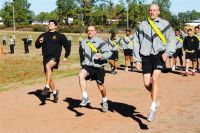FORT POLK, La. — The winds of change are blowing through the Army’s Physical Readiness Training Program, and Fort Polk, La., is taking the initiative to stay ahead of those changes
“It was about time we took a look at how we did our physical fitness,” said Fort Polk Command Sgt. Maj. Jeffrey Hof. “If you think about it, during peacetime, the all-volunteer Army goal was to take a civilian, break him down to nothing, then build a soldier.”
Using the post’s Noncommissioned Officers Academy as its conduit, Hoff and the Joint Readiness Training Center have come up with a plan to ensure each battalion on post has someone versed in the new program to lead the change.
“How many times did you run 10 miles in Afghanistan or Iraq?” Hof asked a collection of sergeants and staff sergeants during a class on the new PT program held on Dec. 1, 2010. “You didn’t. That’s why it’s important to make these changes to the program. It incorporates scientific effort from doctors who understand the human body.” The new PT “manual” is Training Circular 3–22.20, replacing the old Field Manual 21–20. Sgt. 1st Class Vernon Alcorn, chief of training for Fort Polk’s NCO Academy, was the lead instructor for the class on the new practices given to noncommissioned officers from each battalion in early December. He said Army PT has not really changed all that much over the years.
“The way we conduct that PT has changed,” he explained. “We’re working to get our soldiers physically fit and better able to complete their war-fighting tasks.” Alcorn said the new program goes along with what soldiers do in combat situations.
“The longer runs are going away,” he said. “It will be more like a track meet, with sprints and shorter runs. You can still do unit runs, but you won’t do the same thing every day.”
Staff Sgt. W.B. Fancher and Staff Sgt. John McKenna, instructors at Fort Polk’s NCO Academy, were two of the cadre who helped to train the post’s junior NCOs on the new PT program. “FM 21–20 trained soldiers for one thing only: The PT test,” Fancher said. “The new program helps soldiers perform all of their combat roles, from jumping off the rear of a truck to clearing a room of combatants.”
Fancher listed three reasons for the new program:
— Reduce injuries — building muscles in areas not normally used allows for muscle recovery;
— Combat efficiency — Correlates to actions used in combat and relates to warrior tasks and battle drills; and
— Instill discipline — Gets soldiers used to taking commands from leaders. Soldiers must be disciplined to survive in combat.
The program’s goal is to develop soldiers who are physically capable and ready to perform their duty assignments or combat roles. Once the program is in place, McKenna said, soldiers and leaders will see its benefits.
“It’s going to help them with their warrior tasks and battle drills,” McKenna said. “We want to show Fort Polk’s leadership how the program works and how it will help them accomplish their mission, whether in garrison or down range.”
McKenna said the new program is a total body workout. It incorporates old-school exercises like the eight-count pushup, the squat bender and the bend and reach, along with new drills such as the back bridge, quardraplex and medial leg raise.
“It doesn’t just train for the PT test, which is pushups, sit-ups and a two-mile run,” he said. “It works a soldier’s core and upper and lower body. It also works the cardiovascular system.”
McKenna said soldiers should not be concerned that the new PT program will cause their PT test scores to drop. “There is a lot of interval training — a lot of short distance, fast running,” he said. “While it might not seem like you’ll be able to run as fast, soldiers will see an improvement in their two-mile times. And the end result is it gets soldiers to a level of fitness the Army needs.”
One change McKenna noted was that time, not distance, is now used to govern running. “The manual says 30 minutes for the run, not a distance,” he said.
Alcorn said the new program is an excellent way to standardize unit PT and meet the command sergeant major of the Army’s intent to see Soldiers doing PT properly and to standard. Fancher, speaking on the second day of the local two-day PT class for the post’s junior NCOs, said some of the soldiers were already feeling the results of the new exercises. “We’ve turned a couple of heads,” he said. “But there are still skeptics.”
Alcorn said those who consider themselves “PT animals” are more likely to resist the change.
“Standardization takes away from the ‘I can do more than you’ attitudes,” he said. “Everybody is different; body types are different. The new program is a total body workout, both strength and endurance — every session. It’s strict and formal and geared to all types of soldiers.”
McKenna said the intent of the program is to provide a 60-minute workout to start, eventually building up to about 90 minutes. A typical PT session would include 15–20 minutes of warm-up exercises, 30–40 minutes of cardiovascular or muscular work, followed by 5–10 minutes of cool-down exercises.
“The manual is full of great exercises to do during each session, so there’s no reason to become bored with doing the same thing every day,” McKenna said. The opinions of the junior NCOs who attended the WLC’s class were varied, but most said they were willing to give the new program a chance.
“It’s going to take some getting used to,” said Sgt. Christopher Nordin, Headquarters and Headquarters Detachment, 88th Brigade Support Battalion, 1st Maneuver Enhancement Brigade. “I had to get used to not stretching, which is completely different. Apparently a study by scientists say our old style of stretching actually put our muscles to sleep. I guess I believe the scientists.”
Staff Sgt. Monnicia Jackson, 21st Chemical, Biological, Radiological and Nuclear Company, 83rd CBRN Battalion, said the new program is an improvement. “It’s going to cut down on injuries,” she said. “I think the core workout is best; it provides an overall body workout.”
She did note one area that she would have to work on. “The turns on the shuttle runs will take getting used to,” Jackson said. “You’ve got to be coordinated.” Staff Sgt. Kevin Wellington, Headquarters Company, 4th Battalion, 353rd Infantry Regiment, 162nd Infantry Brigade, said he likes the fact that the program focuses on combat tasks. “Pushups and sit-ups are great, but not what we’re doing in Afghanistan or Iraq,” he said. “The new program is battle focused.” McKenna said once the program is fully implemented, it consists of three phases.
“There is an initial conditioning phase, toughening phase and sustaining phase,” he said. “Most Soldiers at Fort Polk are already through the initial conditioning phase and will begin in the toughening phase.”
The toughening phase develops foundational fitness and fundamental movement skills, McKenna said. The sustaining phase continues physical development and helps the Soldier maintain a high level of physical readiness.
“Soldiers must do exercises correctly before moving to the next phase,” McKenna said. Frank Palkoska, the U.S. Army Physical Fitness School director, said the old fitness program was flawed. “You had units that said, ‘all we’ve got to do is pushups, sit-ups and run, and the more we run, the better we’ll be.’ That’s a flawed concept.”
Palkoska said there is a false assumption that if you score high on the APFT, you can do everything a Soldier needs to do.
“You can’t take a 130-pound marathon runner, put 120 pounds on his back and march him at 10,000 feet (elevation) in Afghanistan,” he said. “Those are the types of issues that led us to the development of the new doctrine.”
Hof said it’s the “right time” to change the PT program.
“We are in the ninth year of a two-front war,” he said. “We don’t necessarily need soldiers who can run from tower-to-tower, although there is nothing wrong with that,” he said. “But we do need soldiers who are physically fit, can complete their warrior tasks and battle drills and survive on the battlefield. The new PT program will help our soldiers do that.”
Source:
U.S. Department of Defense
Office of the Assistant Secretary of Defense (Public Affairs)

 von
von 
